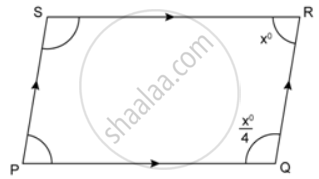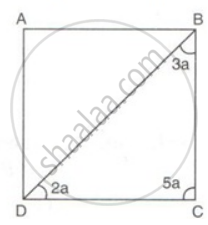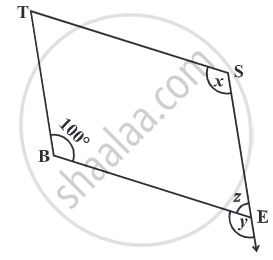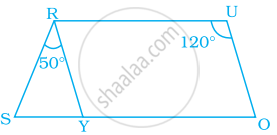Advertisements
Advertisements
Question
In the given figure, ABCD is a parallelogram, find the values of x and y.
Solution
ABCD is a parallelogram.
Opposite angles of a parallelogram are equal.
∴ ∠A = ∠C
⇒ 4x + 3y - 6 = 9y + 2
⇒ 4x - 6y = 8
⇒ 2x - 3y = 4 ....(i)
AB || CD and AD is the transversal.
∴ ∠A + ∠D = 180° ....(Co-interior angles are supplementary)
⇒ (4x + 3y - 6) + (6x + 22) = 180°
⇒ 10x + 3y + 16 = 180°
⇒ 10x + 3y = 164 ....(ii)
Adding equations (i) and (ii), we get
12x + = 168
⇒ x = 14
Substituting the value of x in (i), we get
2 x 14 - 3y = 4
⇒ 28 - 3y = 4
⇒ 3y = 24
⇒ y = 8
Hence, x = 14 and y = 8.
APPEARS IN
RELATED QUESTIONS
In a parallelogram `square`ABCD, If ∠A = (3x + 12)°, ∠B = (2x - 32)° then find the value of x and then find the measures of ∠C and ∠D.
In case of a parallelogram
prove that:
(i) The bisectors of any two adjacent angles intersect at 90o.
(ii) The bisectors of the opposite angles are parallel to each other.
In the given figure, AP is the bisector of ∠A and CQ is the bisector of ∠C of parallelogram ABCD. 
Prove that APCQ is a parallelogram.
In the following figures, find the remaining angles of the parallelogram
Find the measures of all the angles of the parallelogram shown in the figure:

Opposite angles of a quadrilateral ABCD are equal. If AB = 4 cm, determine CD.
The sum of adjacent angles of a parallelogram is ______.
In parallelogram FIST, find ∠SFT, ∠OST and ∠STO.

In the given parallelogram YOUR, ∠RUO = 120° and OY is extended to point S such that ∠SRY = 50°. Find ∠YSR.

